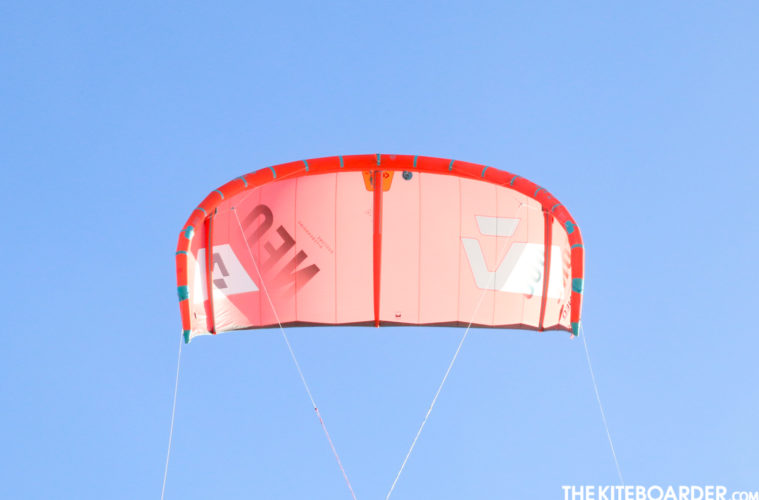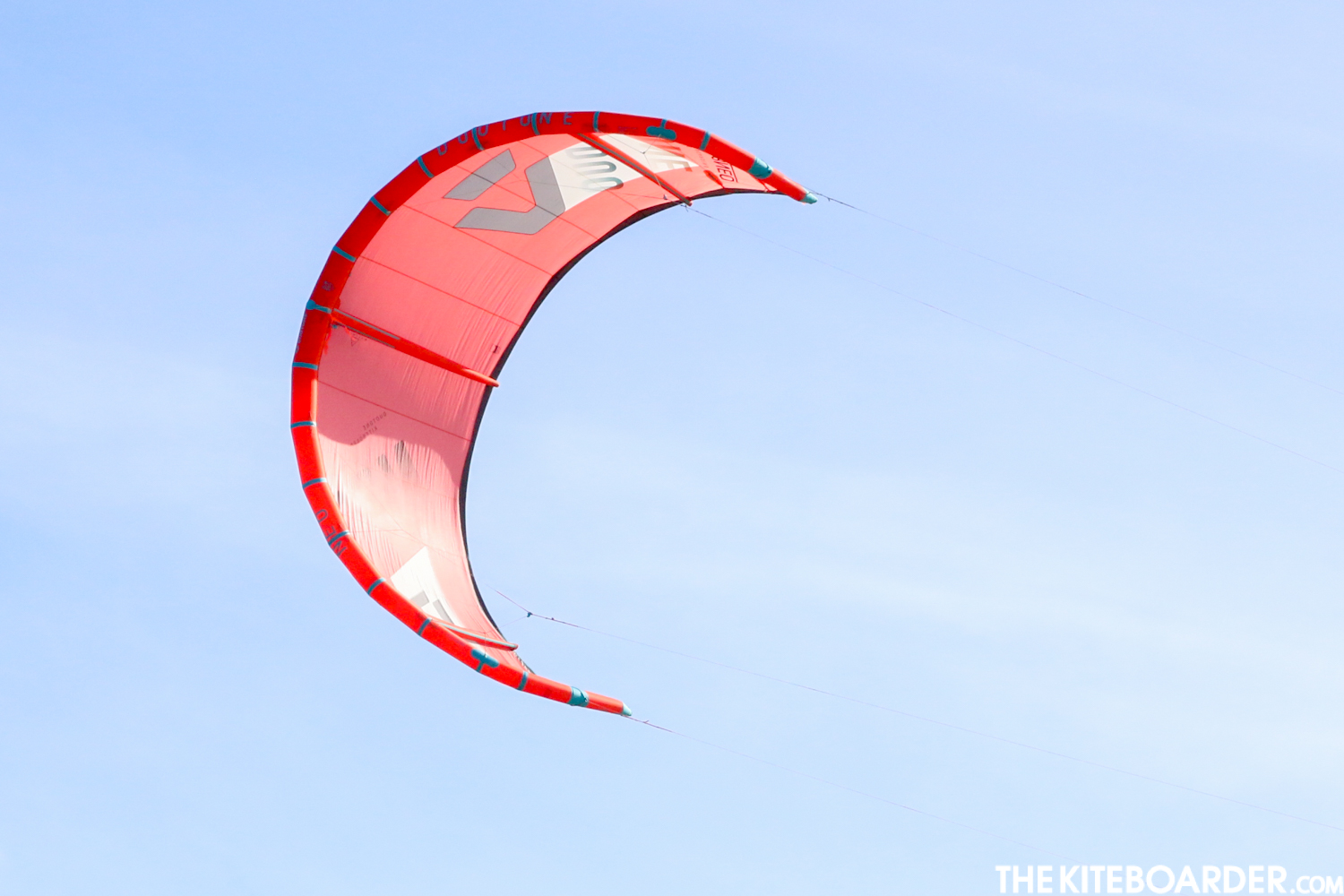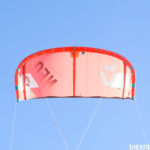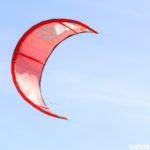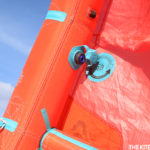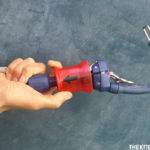Sizes Available: 3, 4, 5, 6, 7, 8, 9, 10, 11, 12m
Sizes Tested: 6, 8, 11m
Duotone Says:
The Neo is the choice of our highly decorated wave riding team, Airton Cozzolino, Matchu Lopes, Sebastian Ribeiro, James Carew and Patri McLaughlin ”” all choose the Neo to compete on the GKA Strapless World Tour. It has won more world titles and events than any other wave kite. With the move towards strapless riding, the Neo now has tuning options for waves and depower or you can set it up for strapless freestyle and freeriding. It’s been one of the most popular kites in the Duotone lineup for a long time, and it’s easy to see why. On the wave, it offers dynamic handling and incredible drift when you want to freeride it’s an easy going companion. The kite has a unique profile that develops enormous amounts of power, Neo riders are often on one or even two sizes smaller than everyone else at the beach, this means the kite is even more responsive. While it has enormous amounts of power, the depower is incredible, more than that though, even when fully sheeted out the steering is exceptionally reactive and precise. Whether you are riding a monster at One Eye, pulling a strapless kiteloop 20 feet up or just slaying some Euro mush, the Neo puts you in total control at all times. If surfboards are your kite life, you need the Neo in your quiver.
Visit for more info: https://www.duotonesports.com/kiteboarding/kites/neo/
Our Testers Say:
“The Neo mixes the quintessential powerful properties of Duotone kites with stability and drift, creating an exhilarating and smooth ride that can take you 90% to the moon and facilitate super fun wave riding.” // Ray Borg
“Steady pull, good drift, easy maneuvering with fast turning speed, decent boosts with excellent upwind ability, lighter bar pressure and great relaunch.” // Brad Poulos
“Goes upwind with decent boost/hangtime like a high aspect kite but features the drift, stability and low-end power and pivotal fast turning of a lower aspect surf kite: the best of both worlds.” // Dray Murray

TKB Says:
The Neo is back for another year, receiving some subtle changes that accentuate its reputation as not only one of the leading surf kites on the market but a kite that increasingly offers user-friendly handling that works for freeride and foilboarders looking to carve. The Neo’s 3-strut platform with sweptback wingtips has the typical surf look, with Ken Winner introducing small changes to how the kite flexes during turning and a new trailing edge design along with other subtle canopy changes to reduce the kite’s overall weight and increase performance. The Neo uses Duotone’s large diameter inflation valve dubbed the ”˜Airport Valve II’ which connects directly with Duotone’s pump hose without the use of a nozzle; the inflation system’s twist valve rotates with the insertion of the hose to keep air locked in the kite. Deflation can happen through both the inflation valve and a dump valve on one side of the kite, making both inflation and deflation quick and easy. The Neo features a two setting front bridle that utilizes a single slider to change the angle of attack. Set the bridle connection between blue and black and the pivot point is shifted forward for ‘High Depower.’ Move the attachment back between blue and black and you get ‘Medium Depower.’ The front bridle attachment points end in knots and the wingtip attachment points end in larks head loops. The Neo also features the Adaptive Wingtip which is a wingtip bridle that offers two settings: ‘Soft’ is the farther aft position and ‘Hard’ is the farther forward. The trailing edge features a minimal double ripstop edge and the wingtip features two small battens on each side.
The first aspect of Neo performance that we noticed was its super crisp steering response with a tight pivot turning arc that makes it very easy to put the Neo exactly where you want it. This snappy turning response continues well into the larger sizes. The Neo has been known historically for its grunty power, but this year’s Neo seems to find an excellent balance between constant good solid pull that doesn’t overwhelm with good depower, even when using the front bridle’s ‘Medium’ depower setting. Testers highlighted the Neo’s excellent upwind ability and gave the Neo’s drift ability the highest scores in the test. When you drive towards the kite it eats up excess line tension and has excellent steering response with lighter line tension. Testers who rode the kite on the ‘Hard’ setting credited the Neo with medium-plus bar pressure and those who tested it on the ‘Soft’ setting commented on the Neo’s light bar pressure and very comfortable handling. The Neo likes to sit a little deeper in the window. In comparison to the more performance freeride kites in Duotone’s lineup, the Rebel and Evo, the Neo is really comfortable flying in the center of the window. The Neo scored high marks on relaunch; with its sweptback wingtips, it relaunched easily from dead downwind on its nose, with a quick pivot onto its wingtips and launching straight from the bottom. Testers commented on the Neo’s reasonable lift and hangtime, leading to fun and friendly airs, falling short of the high boosting you get out of the Rebel and Evo. And to boot, this product, like all the Duotone products, is also ‘Carbon Neutral’ so if you’re a pessimist on the future of our current wind patterns in light of climate change ”” you can feel good about this single purchase decision helping to keep the status quo (perhaps).
While there’s plenty of room for freeride crossover into jumping and foilboarding, the heart of the Neo is in riding waves. It’s crisp, quick and easy steering and easy kite positioning in the middle of the window in addition to its ability to build and dump power and pull effortlessly while maintaining line tension as you choose lines directly with the wind make the Neo a versatile machine with extra tuning options that can be optimized for offshore/onshore and all types of rider preferences.
The Neo can be flown with either the Click bar or the Trust bar; descriptions of both bar options are below.
The Click bar was the first bar to scrap the dangling power strap and integrate power tuning into the bar and with four years under its belt, it’s now got the proven track record to cast aside doubts. The Click bar is available in two sizes, either the smaller fixed-length 42cm wide bar with 22m (20m+2m extension) lines or the original 49cm length with 24m (22m+2m extension) lines. The Click bar features a single centerline safety depower system and an adjustable attachment point that allows you to swap the height of the center lines’ V (it’s worth noting that you don’t have to re-thread the entire length of a line through a ring to accomplish the change). The outside lines end in knots and the center lines end in loops. The Click bar features a molded plastic throw line that untwists itself after you spin, a sliding stopper to adjust the length of throw and Duotone’s proven push away quick release. The quick release when opened horizontally, locks into an open position, holding the gate open. Reassembly is easy: one hand inserts the loop back into position and pushes on the catch button while the other hand raises the quick release handle so the catch can move back into its closed position and then the handle is moved back into the locked position.

The Click bar can be purchased with one of the four chicken/connection loop options that are tailored to your specific style of riding. Most freeride oriented kiters might choose the Freeride connection loop which is the smallest option, keeping the bar close to your body. The historically normal-sized loop is now called the ”˜Freestyle Kit,’ which is sized in the middle for both hooked and unhooked riding. For riders that unhook all day long, there is a large ”˜Wakestyle’ loop and for those that only ride with a surf slider rope, there is the ”˜Rope Harness Kit,’ which is a small loop with an integrated metal slider to reduce friction and keep the bar close to the rider. Swapping the loops out is easy; you just need a fin key to remove a ¾ inch set screw to change out the desired loop. The Click bar settles the debate between above or below the bar tuning by placing it exactly at your fingertips. The twisting motion for powering up takes a little bit of focus while riding at first and the button for depower is easily accessed at all times. While it’s a big shift from the systems we have come to know, seamless controls like this are the future of the sport. The ratchet knob built into the bar end is easy to grab a hold of and easy to rotate once you have some familiarity with it and works while kiting with easy tuning on the fly. The Click bar also integrates two visual indicators that reveal the power position the bar is set to; one is located on the bar itself, moving left to right, and the second is a small red indicator on the leader line for the right outside line. You don’t realize how you visually assess the trim strap’s position until it is gone, so these indicators are actually a very nice feature. Compared to other systems, the mechanics of Duotone’s Click bar is entirely closed, which means you won’t be washing it out. The Click bar features retractable bar bungees, soft bar ends with integrated floats, a fairly dense EVA grip that feels asymmetrical in your palm with subtle raised bumps between your fingers, and a very comfortable stamp pattern running the entire length of the bar.

The second bar option for Duotone kites is the tried and true Trust bar which received a colorway change this year that sets it apart from the Click bar’s orange and blue chassis. The Trust bar’s left float and bar end are now colored a vibrant yellow to indicate the correct orientation. The Trust bar is a standard 4-line bar with an optional 5th line aftermarket upgrade package, so in theory, you could switch back and forth between 4 and 5-lines from the same base bar purchase. The Trust bar is a dual adjustable length bar that comes in two options, 42/49cm and a 46/53cm length. On the smaller bar, you can choose between 19 or 22m lines and on the longer bar, you can choose between 24 and 27m lines. Duotone feels line length is an important tunable feature to match with your kite and style of riding. Our kites came with the 4-line base version with the single centerline safety depower that runs up to one of the bridles. The center lines are knotted for rigging purposes and the outside lines end in loops. The adjustable length spectra throw line features a tuning cleat with a magnet on the depower strap to keep it in place. The Trust has a push away quick release with a below the bar hand swivel that also functions as a quick-release travel guard. At the time of purchase, you can select from four different chicken loop options (Wakestyle, Freestyle, Freeride and Rope Harness). We tested the bar with the Freestyle loop, but we think the Freeride loop is an excellent idea for those kiters that won’t be riding unhooked. The Trust features a spectra trim/throw line, a sliding stopper for long tacks and a firm molded chicken finger to prevent accidental unhooking. The padded bar ends are tunable and offer integrated floats and retractable bar bungees for a clean wrap up. In addition to adjusting the length of the bar, you can adjust the length of the outside lines by pulling the bar ends apart and choosing from three color-coded knots for length options (green/blue/red). The bar grip is fairly plush EVA with middle of the road texture which makes the Trust a very comfy and feature-rich bar. The Trust bar is a long time favorite of testers and the limited changes to the bar this year lends credence to the proposition; don’t mess with perfection.
Visit for more info on the bar: www.duotonesports.com/kiteboarding/bars/

Want to view all our 2020 Freeride, Light Wind and Wingsurf Gear Reviews in one convenient digital guide? Get free access HERE. If you’re already a subscriber, thank you for your support! Log into your account to view our 2020 Freeride Gear Review Guide.


